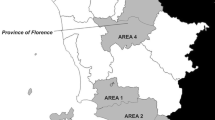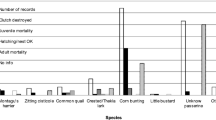Abstract
The methods for and the problems of recognizing bird and rodent damage are described. For birds the methodology for assessing the damage, and the necessary statistics for determining sample design and sample size exist. Damage is measured either by visual estimation of the percentage loss (sorghum, maize, millet) or by weighing/comparing of damaged/undamaged spikes/panicles (wheat/rice). Sampling usually involves randomly selected transects. A system is also available for assessing bird damage over large areas of District, Regional or even countrywide levels involving aerial surveys of crop hectarage and ground teams sampling damage levels at randomly selected points.
For rodents, the methodology is less well established but damage in the field is usually quantified in terms of the percentage of rows of cereals destroyed at germination (maize) or by the number of cut stems compared to uncut stems in sample quadrats (wheat, barley).
Manpower and resources for bird control do not often extend beyond control operation to damage assessments. As a result the necessity for and success of bird control has to be evaluated in terms of diminishing farmer complaints or expressions of farmer gratitude rather than objectively in terms of crop saved or cost-effectiveness. It is suggested that in the long run, emphasis must inevitably switch to damage assessments as the economic pressures on Africa continue to increase.
Résumé
Les methodes et problemes de recognition des degats causes par les oiseaux et rongeurs sont decrits. Pour les oiseaux la methodologie d’evaluation des dommages et les statistiques necessaires à la determination de l’echantillon type et sa grosseur existent. Le dommage est mesuré soit par estimation visuelle des pertes en pourcentage (sorgho, mil, mais), soit en pesant/comparant les epis/panicules (blé, riz) endommages/non-endommages. Habituellement le prelevement des echantillons se fait au hasard. Un systeme d’evaluation de ceux causés par les oiseaux sur grande surface de district, region ou a l’echelle du pays implique la surveillance aerienne des cultures par hectare et l’equipe de terrain prelevant le degré des degats a des points choisis au hasard. Pour les rongeurs la methodologie est moins bien etablie, mais les dègâts en champs sont generalement quantifies en terme de pourcentage de cereales detruits par rangée a la germination (mais) ou par nombre de tiges coupées comparée à celles intacts des carrés prelevés (blé, orge).
La main d’ouevre et les ressources pour le controle des oiseaux ne s’etend pas souvent au de la des operations d’evaluation des degats. Comme consequence la necessité ou le succès de ce travail ne peut s’estimer qu’en terme de reduction de plaintes ou d’expression de gratitude de la part des planteurs, et non en terme de culture epargnées ou de cout effectif. Il est suggèré qu’à long terme l’accent soit inevitablement mis sur l’evaluation des degâts au fur et à mesure que les pressions economiques sur l’Afrique continuent d’accroitre.
Similar content being viewed by others

References
Bruggers R. L. (1980) The situation of grain-eating birds in Somalia. Proc. 9th Vertebrate Pest Conf., Fresno, Calif. 9, 5–16.
Bruggers R. L., Bohl W. H., Bashir S. El, Hamza M., Ali B., Besser J. F., DeGrazio J. W. and Jackson J. J. (1984) Bird damage to agriculture and crop protection efforts in the Sudan. FAO Plant Prot. Bull. 32, 2–16.
Elliott C. C. H. (1979) The harvest time method as a means of avoiding quelea damage to irrigated rice in Chad/Cameroun. J. Appl. Ecol. 16, 23–35.
Hopf H. S., Morley G. E. J. and Humphries J. R. O. (1976) Rodent damage to growing crops and to farm and village storage in tropical and sub-tropical regions. Centre for Overseas Pest Research Tropical Products Institute, London, U.K.
Jaeger M. M. and Erickson W. A. (1980) Levels of damage to sorghum in the Awash Basin of Ethiopia and the effects of the control of quelea nesting colonies (1967–1979). Proc. 9th. Vert. Pest Conf., Fresno, Calif. 9, 21–28.
Plowes D. C. H. (1955) Queleas in Southern Rhodesia CCTA/CSA 55, 1–13.
Taylor K. D. (1968) An outbreak of rats in agricultural areas of Kenya in 1962. E. Afr. Agric. For. J. 34, 66–77.
Author information
Authors and Affiliations
Rights and permissions
About this article
Cite this article
Elliott, C.C.H. The Assessment of On-Farm Losses Due to Birds and Rodents in Eastern Africa. Int J Trop Insect Sci 9, 717–720 (1988). https://doi.org/10.1017/S1742758400005592
Received:
Published:
Issue Date:
DOI: https://doi.org/10.1017/S1742758400005592



